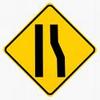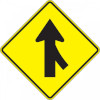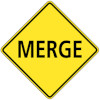 One correspondent observed that "It seems that drivers in BC generally have a big problem when it comes to merging. In this case let's say from two lanes to one. In the normal course of events merging shouldn't be any hassle at all - take turns, one from the left then one from the right - it all moves along nicely, and has a minimal effect on holding up traffic. Not in BC! Here it appears to be everyone for him / herself."
One correspondent observed that "It seems that drivers in BC generally have a big problem when it comes to merging. In this case let's say from two lanes to one. In the normal course of events merging shouldn't be any hassle at all - take turns, one from the left then one from the right - it all moves along nicely, and has a minimal effect on holding up traffic. Not in BC! Here it appears to be everyone for him / herself."
In A Perfect World
In a perfect world the reader would never have raised this issue. We would all be courteous to each other and take turns when we were presented with a situation where merging was required. All would proceed happily and no one would have to spend more time than the other waiting their turn.
Merging Traffic Ahead
The merging traffic sign warns motorists on a main roadway that they may encounter vehicles entering the lane ahead.

The sign will be installed on the side of the roadway on which merging traffic will be encountered, and positioned so as not to obstruct the driver’s view of those vehicles about to merge.
Merging
The merge sign warns motorists facing the sign that they must merge into another traffic lane ahead.

The sign will be used at freeway/expressway on-ramps (or other such one-way approaches that merge with a major road at a small angle), provided that the available parallel distance on the ramp is sufficient to allow a vehicle to reach the highway posted speed before leaving the ramp and entering the outer through lane of the freeway/expressway.
When Your Lane Ends
The lane ends sign indicates a reduction in the number of lanes of pavement ahead either from the right or from the left.

The sign is only used for the reduction of a group of continuous lanes, and, therefore, should not be used in advance of an acceleration lane.
When You Are Merging
When your lane ends or you are the driver merging with other traffic, the onus is on you to move over safely. You must not affect the travel of another vehicle.
Learn to Drive Smart explains how to merge on pages 55 and 56. The advice involves finding a safe gap beside your vehicle by adjusting your speed and then moving over.
Drivers around you should exercise courtesy by helping to establish that safe gap. Move over into an empty lane or adjust speed accordingly.
The Zipper Merge
Doing the Zipper Merge is the preferred behaviour when you are approaching a lane closure and traffic is starting to back up.
When Merging Goes Wrong
The case of Doyle v Hubick is an example of liability for a collision that resulted when a merge went wrong on the Sea to Sky Highway near Pemberton.
How To Video
Share This Article
In your post you have indicated that being kind and making way for others is the correct way of handling merging traffic. Further you admit that in a perfect world this would be the case. However, the flip side of this pollyanna view of "how things ought to be" is the "squeezlers". You know who I mean, the folks who can see the very large white arrows on the pavement indicating they are now running out of space, but refuse to smoothly merge. Instead they press onward until there is no space left and then force their way into the lane you are occupying. Then if you don't stand on your own brakes to accomodate them, you get the lecture of "but you are supppooosed to TAKE TURNS!" [said with righteous indignation]
THIS is why is it not a law, and it is not a reasonable suggestion to drivers to expect or even demand that every other driver who has payed attention to the signs and safely moved into the correct lane, make way for someone not driving proactively and with full attention to the roadway. It is the very unsafe practice of entitlement that your solution suggests that create chaos. As I understand it, every driver is expected by law to understand and follow the posted roadway signs and or lane markers. For the drivers that do so to suddenly be placed in a situation where they have to brake to avoid a collision by someone that is obviously not paying attention, or is simply trying to get ahead, is unsafe and unreasonable. Promoting the "lets all take turns and play nice" sets up the situation we have currently, people that ride the right lane till the pavement ends and feel entitled to the space you are driving in. Bottom line is, be responsible for your control/placement of your vehicle and do not assume that another driver is responsible for YOUR safety for you.
- Log in to post comments
Well, there is a difference between a merge and a lane ending. When it is a genuine merge, then you are required to take turns. When it is a lane ending, then the responsibility is that the driver leaving the lane that is ending must do so without affecting others.
This is an article about merging, not about lane ending, which is also dealt with on the site in a separate article.
- Log in to post comments
Here is a scenario that confuses me. You are in a lane that has a merging lane coming into it. In the merging lane beside you there is a big truck and you are beside the front of his truck. He decides to move over into your lane and just drives over when the only place you have to go is on the shoulder or get run into by him. Does the truck have the right to run you off the road or should he be attempting to move over once you are completely clear of his front bumper?
- Log in to post comments
I'm going to assume that you mean a situation where two lanes in one direction are ending and the truck is in the right lane and you are in the left lane. The truck comes to the end of the right lane and begins to move to the left where you are. If this is not the case, let me know!
This is not a merge situation, it is the case of the truck's lane ending and the driver being required to change lanes. He must do so without affecting any other traffic, which means in this case that he should slow and drop in behind you. Hopefully there is room there and that any traffic behind you is not jammed up on your bumper intent on being ahead of the truck.
Legally, they can drive like this and it is up to the truck to find a way in, but practically, sharing the road is a good thing to do. A defensive driver would be anticipating the difficulty and rather than forcing the truck to brake at the end of the lane would have made room to accomodate it.
- Log in to post comments
I can't find any reference to the "take turns when it is a merge, as opposed to safe to lance change" in the BC MVA, could you please provide a reference / link?
Thanks
- Log in to post comments
You can find legal definitions of terms in Section 1 and Section 119 of the Motor Vehicle Act. If the term you are looking for is not listed, then the generally acceptable definition is the one found in a current Canadian dictionary.
If you were looking at a regulation, the Motor Vehicle Act Regulations for example, the definitions in the related Act would also apply to the regulation in addition to the definitions contained within the regulation.
- Log in to post comments
I have been looking and cannot seem to find an answer to my question, hopefully I can find help here.
Who has right of way when two vehicles are merging into the same lane at the same time? Here is the situation: Three lanes, one car in the right lane, one car in the left lane and both are merging into the centre lane. One vehicle in just infront of the other. Who would have the right of way in this case? And who might be (more) at fault? I have been in several almost accidents and have witnessed dozens more almost accidents. Who has the right of way?
Thank you.
- Log in to post comments
Nobody. In BC law, no driver is ever deemed to have the right of way - but quite often, they are required to give it.
The situation you describe would surely have signs and/or lane markings indicating that one or more of the lanes is ending, necessitating a lane change by vehicles in that lane?
- Log in to post comments
The situation I am asking about is, for example, on an at least three lane highway. No lane endings. Just two cars who each want to be in the middle lane.
You are saying that there is no rule governing this situation, and that seems like an unfortunate oversight. I guess it is up to the better driver to avoid the potential carnage.
Thank you for responding.
- Log in to post comments
... it's not a merge. It is two vehicles, each making a lane change (into the middle lane) at pretty much the same time.
Which takes us back to Section 151(a) which puts the onus on any driver making a lane change to do so legally and safely.
Should they meet in the middle, so to speak, I suspect that ICBC would apportion blame 50/50 - unless there was some significant factor such as a failure to signal - 151(c) - the maneuver in advance, for instance.
I have been told by ICBC claims adjustors that unsafe lane changing is the cause of a significant number of collisions.
In 2014, police in BC addressed this problem by issuing 0.269% of all traffic tickets for Unsafe Lane Change, and 0.403% for Change Lanes Without Signal. Hmmm.
- Log in to post comments
... to this statement from our esteemed site host:
Well, there is a difference between a merge and a lane ending. When it is a genuine merge, then you are required to take turns. When it is a lane ending, then the responsibility is that the driver leaving the lane that is ending must do so without affecting others.
Not that I'm trying to be difficult, but I don't think the law necessarily supports this statement.
Let's consider a couple of different scenarios, please.
Being as I live and work much of the time on the north shore of the lower mainland, I've spent many happy hours trying to get onto the Lions Gate Bridge, either from North Vancouver or West Vancouver. The situation here always has two lanes from each jurisdiction having to get together as one, and oftentimes (when there is only one southbound lane open) the bottleneck repeats.
At no time is one or another lane determined to have ended, or been instructed to merge (although at one time some years ago, there were warning signs that said 'Merge Alternately' which seemed appropriate). Fortunately, these days, drivers have continued the habit of zipper merging for the most part so it all works out pretty much.
Other scenario: a Freeway Merge. Here, you typically have signs warning traffic on the on-ramp to merge - but you also have signs on the freeway warning the traffic on the freeway that other traffic will be merging. Note how the term I'm using here is 'Warning' - yellow diamond signs with black writing on them: NOT black and white and red regulatory signs denying the traffic coming in the right of way.
So in this instance, with two roadways coming together (the on ramp and the freeway) it's arguable whether Section 173 (2) applies, (in which case, the merging vehicle should be given the right of way) or Section 151 (1).
Me, I don't see it as a lane change.
- Log in to post comments
I noticed a big omission concerning the merging business. That is that the wiggly thing on the left of the steering column that activates the turn signals. Did you intentionally leave that part of the merge action out, or are you aware, like a lot of drivers are, that newer cars don't have any indicators, because manufacturers have decided them redundant, therefore making the turn indication unnecessary? In this case of a merge, some (many) drivers feel everybody around them should somehow just know how they are going to behave.
Of all the components of vehicle design and operation, the signal indicator is probably one of the least worn out devices in our cars. Pity.
- Log in to post comments
Whether lane changing or merging commonsense and courtesy have to come into play. I would like to see more signage promoting the Zipper merge. I notice a lot of people as soon as they pass the sign of a lane ending immediately move over cutting off other drivers. If more emphasis was put into stay in the lane till it ends then move over traffic would flow a lot better.
When you know the lane is ending no matter which lane you are in think of the other driver and either speed-up or slow down so they have a space to move into.
Two things I believe come into play here. The attitude of some people that if the person merges does so in from of them he is cutting them off and one of those terrible speeders that have to get ahead of them no matter what and Cruise Control and especially adaptive cruise control that keeps a specific distance from the vehicle in front. Unfortunately far too many that use cruise control also put their brains in cruise control and quit paying attention to the traffic around them. If you have a group of vehicles all keeping the same distance apart where is the driver that has to move into the lane to go? In other words if you have a 3 second space between you and the vehicle in front of you and the other cars around you are all the same for the vehicle moving into the lane you are in immediately takes that 3 second gap to 1.5 seconds if done at the mid-point.
And that is what I am trying to point out. When traffic has to merge or change lanes everyone has to play a part in the procedure. Override your cruise control and look around and create a space for the vehicle that has to move into your lane. And if you have a truck riding alongside your front bumper speed up so that he can move in behind you. He has to go someplace? And the vehicle behind you should slack off creating a gap that the truck can fit into.
- Log in to post comments
- Log in to post comments

Squeezling